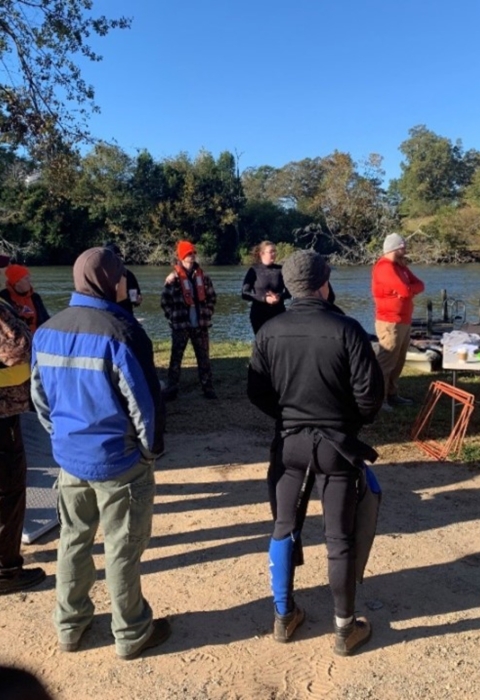Interagency Collaboration Essential for Monitoring Listed Aquatic Snail Species
Due to operation changes from the Allatoona Lake Water Supply Storage Reallocation Study and Updates to Weiss and Logan Martin Reservoirs Project Water Control Manuals, the U.S. Fish and Wildlife Service (Service) was concerned about the potential influence to three listed snails and their habitat, including the painted rocksnail (Leptoxis coosaensis) - threatened, Tulotoma snail (Tulotoma magnifica) - threatened, and Cylindrical lioplax (Lioplax cyclostomaformis) - endangered.
The U.S. Army Corps of Engineers (USACE) recently partnered with the Service to conduct a base-line biomonitoring assessment of threatened and endangered aquatic snails in Choccolocco Creek, Talladega County, Alabama with plans for three additional events over the next nine years. Snorkel and dive techniques were used by participants from the USFWS Alabama Ecological Services Field Office, USFWS Panama City Fish and Wildlife Conservation Office (FWCO), USFWS Warm Springs National Fish Hatchery, USACE Mobile District, Alabama Department of Conservation and Natural Resources, and Auburn University to collect, identify, enumerate snails, and monitor changes over time. This project showcases the use of resources from multiple agencies, USFWS offices, and the USFWS Region 4 Dive Team.
Dive Team Training
In June 2022, members of the USFWS Region 4 Dive Team (Jeff Powell, Morgan Brizendine, Jenna King, and Channing St. Aubin), snorkel team lead Jennifer Grunewald (USFWS), and the USACE snorkel team held a training session at Morrison Springs, FL to meet, train, and review sampling methods and safety protocols. In September 2022, the teams met again at Choccolocco Creek to recon and rehearse the procedures on site with some practice dives and snorkel samples, and determine final equipment needs for the scheduled October 2022 monitoring event. In determining where to sample, Adam Kaeser from the Panama City FWCO was able to complete and produce a bathymetric map using side scan sonar (SSS). The imagery was transferred into GIS and a sampling map was produced based on meso-habitat similarities. Random points were generated for sampling in the multiple habitat classes for each sampling reach.
Battling the Elements at Choccolocco Creek: a routine day for aquatic biologists
Of course, during the scheduled monitoring event, a cold front pushed down and the air temperatures dropped, with morning lows in the upper 20’s to low 30’s F. However, the water temperatures were still manageable in the low 60’s F and the teams were eager to sample the warm waters. The monitoring plan called for sampling three river reaches over three days (lower, upper, and control) with ten dive sites and five snorkel sites per reach. To achieve the monitoring goals of this project, both snorkel and dive methods were required to sample the various depths of Choccolocco Creek.
On each day, the teams assembled bright, early, and cold at the boat ramp to set up base camp and discuss the dive safety plan. Next the USACE collected water chemistry and flow data, while the dive and snorkel teams dressed out. To sample the deeper pool areas, the USFWS dive teams were assembled into two vessels: Team 1 – Jason Ross (Tender), Jeff Powell (Diver), Morgan Brizendine (Diver); Team 2 – Channing St. Aubin (Tender), Jessica Radich (Diver), and Jenna King (Diver). The USFWS snorkel team Jennifer Grunewald, Scott Lamont, and Daniel Morris (volunteer) and the USACE snorkel team assembled into separate vessels to sample shallow riffle areas.
During the three days of sampling, the teams moved upstream from the lower reach to the control reach, collected snails in each reach and habitat type, and were able to complete the project without an incident, accident, or hypothermia. Who knew that a $2 tablecloth cover would also double as an emergency blanket in blocking the wind?
The USFWS Region 4 Dive Team would like to thank the regional office for the ongoing support in providing the training, equipment, and resources to conduct these types of projects in a manner that provides the greatest chance of success.








